Chapter 17.38
SIGNS
Sections:
17.38.030 Sign permit and master sign plan requirements.
17.38.035 Exemptions from sign permit requirements.
17.38.050 General requirements for all signs.
17.38.060 Zoning district sign standards.
17.38.070 Standards for specific sign types.
17.38.080 Nonconforming signs.
17.38.090 Public nuisance, abatement, and violation.
17.38.010 Purpose.
The regulations established by this chapter are intended to appropriately limit the placement, type, size, and number of signs allowed within the city, and to require the proper maintenance of signs. The purposes of these limitations and requirements are to:
A. Avoid traffic safety hazards to motorists, bicyclists, and pedestrians, caused by visual distractions and obstructions;
B. Promote the aesthetic and environmental values of the community by providing for signs that do not impair the attractiveness of the city as a place to live, work, and shop;
C. Provide for signs as an effective channel of communication, while ensuring that signs are aesthetically proportioned in relation to adjacent structures and the structures to which they are attached; and
D. Safeguard and protect the public health, safety, and general welfare. (Ord. 766 § 2 Exh. A (part), 2004).
17.38.020 Applicability.
A. Signs Regulated. The requirements of this chapter shall apply to all signs in all zoning districts.
B. Applicability to Sign Content. The provisions of this chapter do not regulate the message content of signs (sign copy), regardless of whether the message content is commercial or noncommercial.
C. Definitions. Definitions of the specialized terms and phrases used in this chapter are in Article 9 (Glossary) under “Sign.” (Ord. 766 § 2 Exh. A (part), 2004).
17.38.030 Sign permit and master sign plan requirements.
A. Sign Permit and/or Master Sign Plan Required. No sign shall be constructed, installed, or modified, unless a sign permit and, where applicable, master sign plan approval is first obtained in compliance with this chapter, or the sign is allowed without sign permit by Section 17.38.035 (Exemptions from sign permit requirements).
1. Compliance with Standards Required. No sign permit or master sign plan shall be approved for an existing or proposed sign unless the sign is in compliance with all applicable requirements of this chapter.
2. Building Permit Required. The installation of a sign may require a building permit.
3. Compliance with Permit and/or Plan Required. After approval of a sign permit and/or sign plan, each sign site shall comply with the permit and plan.
4. Temporary Signs. Temporary signs shall comply with Section 17.38.070(G).
B. Review Authority.
1. Director. The director shall review sign permit and master sign plan applications and approve only those that comply with the findings required in subsection E of this section. The director may also refer a sign permit application to the design review administration for review and recommendation, either for the individual sign permit, a master sign plan, or as part of a development project that is otherwise subject to design review.
2. Conditions of Approval. The director may require conditions of approval that are deemed reasonable and necessary to achieve the purpose, intent, and objectives of this chapter.
C. Sign Permit Procedures.
1. Application Requirements. An application for a sign permit shall be prepared, filed, and processed in compliance with Chapter 17.60 (Permit Application Filing and Processing).
2. Application Contents. Each application shall include all of the following:
a. Plans for the sign, drawn to scale, showing the proposed location of the sign in relation to other signs on the site and adjacent properties, structures, and uses;
b. A complete color scheme for the sign, and design drawing of the sign;
c. Sufficient other details of the proposed sign to show that it complies with the provisions of this chapter;
d. Written permission from the property owner for the placement of the proposed signs on the site;
e. Computation of the total sign area, the area of each individual sign, the height of each sign, and the total number of existing and proposed signs on the parcel;
f. An accurate indication on the plot plan of the proposed location of each present and future sign of any type, whether requiring a permit or not;
g. If a sign permit application is filed for a site with existing signs, the application shall detail how the applicant will correct all nonconforming signs on the site as part of the installation of the proposed signs; and
h. Other information as required by the department.
D. Master Sign Plan Requirements.
1. When Required. A master sign plan shall be required for:
a. A new nonresidential project with four or more tenants; and
b. Major rehabilitation work on an existing nonresidential project with four or more tenants, that involves exterior remodeling, and/or the modification to fifty percent or more of the existing signs on the site within a twelve-month period. For the purposes of this chapter, major rehabilitation means adding more than fifty percent to the gross floor area of the structures, or exterior redesign of more than fifty percent of the length of any facade within the project.
Each sign installed or replaced within the nonresidential project shall comply with the approved master sign plan.
2. Content of Plan.
a. A master sign plan shall include all the information and materials required by subsection (C)(2) of this section, and shall provide standards for the uniform style, construction, height, size, and placement of signs within the proposed project.
b. A master sign plan shall be included with any planning permit required by the city for the development of the parcel on which the sign is proposed to be located, and shall be processed simultaneously with the other plan.
3. Revisions. The director may approve revisions to a master sign plan in compliance with Section 17.64.090 (Changes to an approved project).
E. Findings for Approval. The approval of a sign permit or master sign plan shall require that the review authority first make all the following findings, as applicable:
1. The proposed signs do not exceed the standards of Sections 17.38.060 (Zoning district sign standards) and 17.38.070 (Standards for specific sign types), and are of the minimum size and height necessary to enable pedestrians and motorists to readily identify the facility or site from a sufficient distance to safely and conveniently access the facility or site;
2. That the placement of the sign on the site is appropriate for the height and area of a freestanding or projecting sign;
3. That a flush or projecting sign relates to the architectural design of the structure;
4. That signs do not unreasonably impair the visibility of existing signs on adjacent properties;
5. The placement and size of the sign will not impair pedestrian or vehicular safety;
6. The design, height, location, and size of the signs are visually complementary and compatible with the scale and architectural style of the primary structures on the site, any prominent natural features on the site, and structures and prominent natural features on adjacent properties on the same street;
7. The proposed signs are in substantial conformance with the design criteria in Section 17.38.050(G); and
8. The proposed signs are of a color, height, letter type, location, material, shape, size, and style that is appropriate for the use of the premises, enhancing to the premises, and harmonious with the surrounding neighborhood.
F. Expiration and Extension of Sign Permit Approval.
1. Approval of a sign permit or master sign plan shall expire twelve months from the date of approval unless the sign has been installed, or a different expiration date is stipulated at the time of approval. Before the expiration of a sign permit or master sign plan approval, the applicant may apply to the department for an extension of an additional twelve months from the original date of expiration. In response to an extension request, the review authority may make minor modifications, or deny further extensions.
2. The expiration date of the sign permit or sign plan shall be automatically extended to concur with the expiration date of the companion building permit or other applicable permits. (Ord. 885 § 2 Exh. A (part), 2019: Ord. 766 § 2 Exh. A (part), 2004).
17.38.035 Exemptions from sign permit requirements.
The following signs are allowed without sign permit or master sign plan approval; provided, that they comply with Section 17.38.050 (General requirements for all signs), and any required building permit is obtained.
A. Nonstructural Modifications and Maintenance.
1. Modifications to sign copy on conforming signs, or changes to the face or copy of conforming changeable copy signs;
2. Nonstructural modifications of the face or copy of an existing conforming sign installed in compliance with a sign plan; provided, the modifications are consistent with the approved master sign plan; and
3. The normal maintenance of conforming signs, except as identified in Section 17.38.080(B).
B. Service Station Advertising Signs. Service station signage as required by California Business and Professions Code Sections 13530 through 13540.
C. Noncommercial Temporary Signs. Noncommercial temporary signs, except as otherwise authorized by California Civil Code Section 713, are allowed without a sign permit, subject to the following requirements:
1. Duration. Temporary signs may be placed and maintained for a total maximum period of seventy consecutive days, no more than two times per calendar year (with a minimum of thirty days between postings), unless a longer time period is granted by the appropriate review authority in conjunction with an approved development project or limited term permit.
2. Placement. Temporary signs shall be located only on private property with the property owner’s permission and shall not be sited so as to impede visibility of the street and/or traffic control signs to motorists, pedestrians or bicyclists.
3. Illumination. Temporary signs shall not be illuminated either internally or externally.
4. Number and Size. Temporary signs shall be limited to a total aggregate sign area of twelve square feet in residential zoning districts or twenty square feet in nonresidential zoning districts unless larger number or sizes are granted by the appropriate review authority in conjunction with an approved development project or limited term permit. See Section 17.38.050(A) for sign area measurement regulations.
5. Height. Temporary signs shall not exceed six feet in height when measured in accordance with Section 17.38.050(B).
D. Governmental Signs. Signs installed by the city, county, or a federal or state governmental agency, including but not limited to, the following:
1. Emergency and warning signs necessary for public safety or civil defense;
2. Traffic signs erected and maintained by an authorized public agency;
3. Legal notices, licenses, permits, and other signs required to be displayed by law;
4. Signs showing the location of public facilities (e.g., public telephones, restrooms, and underground utilities); and
5. Any sign, posting, notice, or similar sign placed by or required by a governmental agency in carrying out its responsibility to protect public health, safety, and general welfare.
E. Miscellaneous Signs. The following are not considered signs for purposes of implementing this chapter and do not require a sign permit though they may be subject to requirements of the city’s design review process and/or issuance of a building permit:
1. Street Addresses. Street address numbers not exceeding twelve inches in height;
2. Official Flags. Flags of national, state, or local governments, or nationally recognized religious, fraternal, or public service agencies; provided, that:
a. The length of a flag shall not exceed one-fourth the height of the flag pole;
b. The height of the flag pole shall not exceed twelve feet within a residential zoning district and thirty feet within a nonresidential zoning district; and
c. No private flag pole shall be located within a public right-of-way or required setback;
3. Ornamentation and Decoration. Symbols, pictures, patterns, and illumination approved as architectural ornamentation or decoration by the director;
4. Architectural Markers. Markers incorporated into building or landscape architecture on private property; provided, that none of these exceed four square feet. (Ord. 885 § 2 Exh. A (part), 2019: Ord. 862 § 2 (part), 2016; Ord. 766 § 2 Exh. A (part), 2004).
17.38.040 Prohibited signs.
All signs not expressly allowed by this chapter shall be prohibited. Examples of prohibited signs include, but are not limited to, the following:
A. Abandoned signs;
B. Animated and moving signs, including electronic message display signs, and variable intensity, blinking, or flashing signs, or signs that emit a varying intensity of light or color, except time and temperature displays (which are not considered signs), and barber poles;
C. Internally illuminated cabinet (can) signs;
D. Off-site signs (e.g., billboards), except as allowed by Section 17.38.070(G)(2);
E. Obscene signs;
F. Pole signs and other freestanding signs over six feet in height;
G. Roof signs;
H. Because of the city’s compelling interest in ensuring traffic safety, signs that simulate in color, size, or design any traffic control sign or signal, or that make use of words, symbols, or characters in a manner that interferes with, misleads, or confuses pedestrian or vehicular traffic;
I. A sign in the form or shape of a directional arrow, or otherwise displaying a directional arrow, except as approved by the director, or as required for safety and convenience and for control of vehicular and pedestrian traffic within the premises of the subject use;
J. A sign attached to or suspended from a boat, vehicle, or other movable object that is parked within a public right-of-way, or located on private property so that it is visible from a public right-of-way; except a sign painted directly upon, magnetically affixed to, or permanently affixed to the body or other integral part of a vehicle that covers no portion of a vehicle window;
K. A sign burned, cut, or otherwise marked on or affixed to a rock, tree, or other natural feature;
L. A sign placed within a public right-of-way, except as provided by Section 17.38.050(E);
M. Temporary and portable signs, except as specifically allowed by Section 17.38.070(G), including the following:
1. A-boards and other portable sidewalk signs,
2. Balloons and other inflatable devices,
3. Flags, except as specifically allowed by Section 17.38.035(E)(2), and
4. Pennants and streamers, except in conjunction with an approved limited term permit or event approved by city council resolution, or as allowed in Section 17.38.070(G). (Ord. 885 § 2 Exh. A (part), 2019: Ord. 862 § 2 (part), 2016; Ord. 766 § 2 Exh. A (part), 2004).
17.38.050 General requirements for all signs.
The following rules shall govern the computation of sign area:
A. Sign Area Measurement. The measurement of sign area to determine compliance with the sign area limitations of this chapter shall occur as follows:
1. Surface Area. The surface area of a sign shall be calculated by enclosing the extreme limits of all framing, emblem, logo, representation, writing, or other display within a single continuous perimeter composed of squares or rectangles with no more than eight lines. See Figure 3-12.

Figure 3-12. Sign Area Measurement
2. Sign Structure. Supporting bracing or framework that is clearly incidental to the display itself shall not be computed as sign area.
3. Multi-Faced Signs. The sign area for a sign with more than one face shall be computed by adding together the area of all sign faces.
4. Three-Dimensional Objects. Where a sign consists of one or more three-dimensional objects (e.g., balls, cubes, clusters of objects, sculpture, or statue-like trademarks), the sign area shall be measured as their maximum projection upon a vertical plane. See Figure 3-13.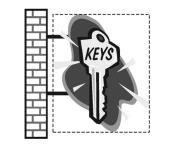
Figure 3-13. 3-D Sign Area Measurement
5. Time and/or temperature device. The area of any time and/or temperature device incorporated into a sign shall not be included in the calculation of total sign area.
6. Sign Lighting. Permanently installed illuminated panels, visible tubing, and strings of lights outlining all or a portion of a structure, other than lighting that is primarily for indirectly illuminating architectural features, signs, or landscaping, shall be deemed “signs” subject to this chapter and shall be counted as part of the allowed sign area. Each line of tubing or lights shall be deemed to have a minimum width of at least six inches for the purpose of are calculation.
B. Sign Height Measurement. The height of a sign shall be computed as the vertical distance from the lowest point of the base of the sign at normal grade, to the top of the highest attached component of the sign. See Figure 3-14.
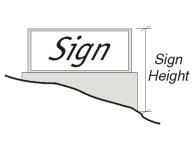
Figure 3-14. Sign Height Measurement
1. Normal Grade. Normal grade shall be construed to be the lower of either the:
a. Existing grade before construction; or
b. Newly established grade after construction, exclusive of any berming, filling, mounding, or excavating solely for the purpose of locating the sign.
2. Where Normal Grade Cannot be Determined. In cases in which the normal grade cannot reasonably be determined, sign height shall be computed on the assumptions that the elevation of the normal grade at the base of the sign is equal to the elevation of the nearest point of the crown of a public street or the grade of the land at the principal entrance to the principal structure on the parcel, whichever is lower.
C. Sign Height Limitations.
1. Maximum Height for Freestanding Signs. A freestanding sign shall not exceed a height of six feet above normal grade.
2. Maximum Height for Signs on Structures. The top of a sign mounted on a structure shall not extend higher than the lesser of:
a. The window sills of the second floor;
b. The top of the wall to which the sign is attached, in the case of a one-story structure; or
c. Twenty feet above normal grade.
See Section 17.38.070(D) of this chapter for exceptions to the above requirements for freeway-oriented signs.
D. Sign Location Requirements. Each sign shall be located in compliance with the following requirements, and all other applicable provisions of this chapter:
1. Each sign shall be located on the same site as the subject of the sign, except as otherwise allowed by Section 17.38.070 of this chapter for a specific sign type.
2. No sign shall project over public properly, or the public right-of-way, except where the city has granted an encroachment permit in addition to a sign permit.
3. No sign shall be placed so as to interfere with the operation of a door or window. A sign that covers architectural features shall be discouraged.
E. Signs Placed Within the Public Right-of-Way.
1. No sign shall be allowed in the public right-of-way except for the following:
a. Public signs erected by or on behalf of a governmental agency to convey public information, identify public property, post legal notices, or direct or regulate pedestrian or vehicular traffic;
b. Bus stop signs installed by a public transit company;
c. Informational signs of a public utility regarding its lines, pipes, poles, or other facilities; or
d. Emergency warning signs erected by a governmental agency, a public utility company, or a contractor doing authorized within the public right-of-way.
2. Any sign installed or placed within the public right-of-way other than in compliance with this section shall be forfeited to the public and be subject to confiscation.
3. In addition to other remedies identified in Chapter 17.89 (Enforcement and Penalties) of this title, the city shall have the right to recover from the owner, or person placing the sign, the full costs related to the removal and disposal of the sign.
4. A sign permit shall not be required for city signs placed within the public right-of-way.
F. Sign Design, Construction, and Maintenance. All signs shall be designed, constructed, and continuously maintained in compliance with the following standards:
1. Compliance with Applicable Provisions. All signs shall comply with the applicable provisions of the uniform codes of the city, any other applicable city ordinances, resolutions, or regulations, and this chapter.
2. Permanent Materials and Attachment. Except for banners, flags, temporary signs, and window signs conforming with the requirements of this chapter, all signs shall be constructed of permanent materials and shall be permanently attached to the ground, a building, or another structure by direct attachment to a rigid wall, frame, or structure.
G. Design Criteria for Signs. The following design criteria shall be used in reviewing the design of individual signs. Substantial conformance with each of the following design criteria shall be required before a sign permit or building permit can be approved.
1. Color. Colors on signs and structural members should be harmonious with one another and relate to the dominant colors of the other structures on the site. Contrasting colors may be utilized if the overall effect of the sign is still compatible with the structure colors and prevailing colors in the surrounding neighborhood (where a theme can be identified).
2. Design and Construction.
a. All permanent signs shall be designed by professionals (e.g., architects, building designers, landscape architects, interior designers, or those whose principal business is the design, manufacture, or sale of signs), or others who are capable of producing professional results.
b. All permanent signs shall be constructed by persons whose principal business is building construction or a related trade including sign manufacturing and installation businesses, or others capable of producing professional results. The intent is to ensure public safety, achieve signs of careful construction, neat and readable copy, and durability so as to reduce maintenance costs and to prevent dilapidation.
3. Materials and Structure.
a. Sign materials (including framing and supports) shall be representative of the type and scale of materials used on the site of the sign. Sign materials shall match those used on the structure and on other signs.
b. No sign shall include reflective material.
c. Materials for permanent signs shall be durable and capable of withstanding weathering over the life of the sign with reasonable maintenance.
d. The size of the structural members (e.g., columns, crossbeams, and braces) shall be proportional to the sign panel they are supporting. In general, fewer larger supporting members are preferable to many smaller supports.
e. The use of individual letters incorporated into the building design is encouraged, rather than a sign with background and framing other than the structure wall.
4. Street Address. The review authority may require that a sign include the street address of the site, where it determines that public safety and emergency vehicle response would be more effectively served than if the street address were displayed solely on one or more structures on the site.
H. Copy Design Guidelines. The city does not regulate the message content (copy) of signs; however, the following are principles of copy design and layout that can enhance the readability and attractiveness of signs. Copy design and layout consistent with these principles is encouraged, but not required.
1. Sign copy should relate only to the name and/or nature of the business or commercial center.
2. Permanent signs that advertise continuous sales, special prices, or include phone numbers, etc., should be avoided.
3. Information should be conveyed briefly or by logo, symbol, or other graphic manner. The intent should be to increase the readability of the sign and thereby enhance the identity of the business.
4. The area of letters or symbols should not exceed forty percent of the background area in commercial districts or sixty percent in residential districts.
5. Freestanding signs should contain the street address of the parcel or the range of addresses for a multi-tenant center.
I. Sign Lighting. Sign lighting shall be designed to minimize light and glare on surrounding rights-of-way and properties.
1. A sign shall be illuminated by lights shining on the sign rather than by lights within the sign; except that a freeway-oriented sign in compliance with Section 17.38.070(D) of this chapter may have internal lighting.
2. External light sources shall be directed and shielded so that they do not produce glare off the site, on any object other than the sign.
3. Sign illumination shall not blink, flash, flutter, or change light intensity, brightness, or color.
4. Colored lights shall not be used at a location or in a manner so as to be confused or construed as traffic control devices.
5. Neither the direct nor reflected light from primary light sources shall create hazards for pedestrians or operators of motor vehicles.
6. No lamp that exceeds fifteen watts shall be placed so that the face of the lamp is visible from a public right-of-way or adjacent property.
7. Light sources shall utilize hard-wired fluorescent or compact fluorescent lamps, or other lighting technology that is of equal or greater energy efficiency. Incandescent lamps shall be prohibited.
J. Maintenance of Signs.
1. Each sign and supporting hardware, including temporary signs, shall be maintained in good repair and functioning properly at all times.
2. Any repair to a sign shall be of materials and design of equal or better quality as the original sign.
3. A sign that is not properly maintained and is dilapidated is a public nuisance, and may be abated in compliance with the municipal code.
4. When an existing sign is removed or replaced, all brackets, poles, and other supports that are no longer required shall be removed. (Ord. 766 § 2 Exh. A (part), 2004).
17.38.060 Zoning district sign standards.
Each sign shall comply with the sign type, area, height, and other restrictions provided by this section, in addition to the provisions of Section 17.38.070, Standards for specific sign types.
A. Low Density and Neighborhood Zones. Each sign in the OSC, OSR, RR, RVL, NL, NM, or NU zoning districts shall comply with the requirements in Table 3-11.
|
Allowed Sign Types |
Maximum Sign Height |
Maximum Number of Signs Allowed per Parcel |
Maximum Sign Area Allowed per Parcel |
|---|---|---|---|
|
Wall or freestanding |
Wall signs: below edge of roof; Freestanding: 4 ft. |
1 of either allowed sign type per street frontage |
12 sq. ft. maximum each; 24 sq. ft. total for all signs |
B. Mixed Use Corridors and Districts. Each sign in the CG, CE, SPD, CD, CI, and IG zoning districts shall comply with the requirements in Table 3-12.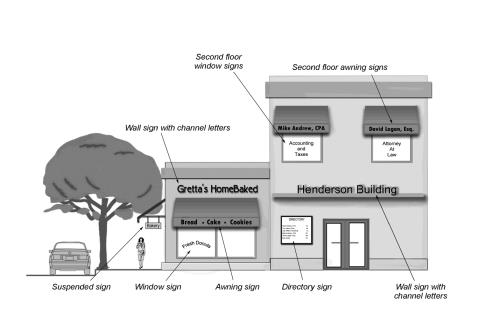
Figure 3-15. Examples of Sign Types
|
Allowed Sign Types |
Maximum Sign Height |
Maximum Number of Signs Allowed per Parcel |
Maximum Sign Area |
|
|---|---|---|---|---|
|
Ground-mounted and Ground-floor Signs |
||||
|
Awning |
Below roof(1) |
Single tenant site or structure: 3 of any combination of allowed sign types per primary structure frontage. |
Maximum sign area per parcel. The total sign area of all signs on a parcel shall not exceed the following: |
|
|
|
|
1 of any allowed sign type per secondary frontage. |
1. |
1 sq. ft. for each linear ft. of primary building frontage; |
|
Freestanding |
6 ft. |
Site or structure with 4 or more tenants: 1 of any allowed sign type per business frontage. |
2. |
0.5 additional sq. ft. for each linear foot of secondary building frontage; |
|
|
|
3. |
Each use is allowed a total sign area of at least 25 sq. ft. regardless of frontage length; and |
|
|
Projecting, Wall |
Below roof(1) |
|
4. |
The total sign area per use shall not exceed 100 sq. ft. |
|
|
|
|
Maximum sign area per building frontage. The total area of all signs on a single building frontage shall not exceed the total linear feet of that frontage. |
|
|
Suspended |
Below eave/ canopy; at least 8 ft. above a walking surface |
|
Site with 4 or more tenants: is allowed an additional freestanding identification sign of 0.25 sq. ft. for each linear ft. of total primary structure frontage, up to 100 sq. ft. maximum. |
|
|
Temporary/ Portable |
||||
|
Window |
See Section 17.38.070(I) |
|||
|
Other Types |
As allowed by Section 17.38.070, Standards for specific sign types |
|||
|
Second Floor Signs |
||||
|
Awning, Projecting, Wall |
Below roof(1) |
1 per tenant space |
12 sq. ft. for each tenant. 1 directory sign not to exceed 12 sq. ft. is also allowed to identify upper floor occupants. |
|
|
Window |
See Section 17.38.070(I) |
|||
Notes:
(1) At least one foot below the top of a parapet, the sill of a second floor window, and/or the lowest point of any cornice or roof overhang.
(Ord. 823 § 2(C) Exh. C (part), 2009; Ord. 766 § 2 Exh. A (part), 2004).
17.38.070 Standards for specific sign types.
Proposed signs shall comply with the following standards applicable to the specific sign type. Each sign type listed in this section shall be included in the calculation of the total sign area allowed on a parcel by Section 17.38.060, Zoning district sign standards, unless this section explicitly provides otherwise. Each sign shall also comply with the sign area, height, and other requirements of Section 17.38.060, Zoning district sign standards, and all other applicable provisions of this chapter.
A. A-Board and Other Portable Sidewalk Signs. Each business may display one A-board or other similar portable sign (Figure 3-16) in compliance with the following standards:
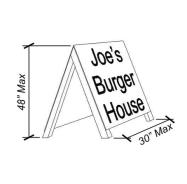
Figure 3-16. A-Board Sign
1. Limitation on Location. An A-board sign shall be allowed only on private property.
2. Sign Size. Each sign shall not exceed a width of thirty inches. Sign height shall be limited to forty-eight inches. Sign height shall be measured perpendicular from the placement surface to the highest point of the A-board sign. A-board signs shall be counted as part of the total sign area on a site for the purposes of determining compliance with Section 17.38.060 (Zoning district sign standards).
3. Sign Placement. An A-board sign shall be placed only on private property within the boundaries of the applicable business’ street frontage, and shall be positioned so that it will not:
a. Obstruct required ADA sidewalk clearance;
b. Impede any line of sight for motorists at vehicular public right-of-way intersections, as recommended by the city engineer; or
c. Interfere with people exiting and entering parked cars.
4. Design and Construction Standards. The review authority shall approve an A-board sign only if it first determines that the design and appearance of the sign, including any graphics and/or text, will reflect attractive, professional design, and that the sign will be durable and stable when in place.
5. Stabilization. The sign shall be stabilized to withstand wind gusts or shall be removed during windy conditions.
6. Daily Removal. The sign shall be removed at the close of business each day.
7. Maintenance. The sign shall be continuously maintained in good condition with no peeling paint or other deterioration.
B. Awning Signs. The following standards apply to awning signs (Figure 3-17) in all zoning districts where allowed by Section 17.38.060 (Zoning district sign standards):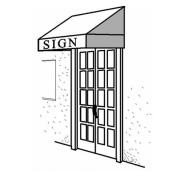
Figure 3-17. Awning Sign
1. Signs on awnings are limited to ground level or second story occupancies only.
2. Awnings shall not be internally illuminated. Direct exterior lighting may be allowed. Translucent awning materials are prohibited.
C. Freestanding Signs. The following standards apply to freestanding signs (Figure 3-18) in all zoning districts where allowed by Section 17.38.060 (Zoning district sign standards):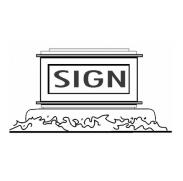
Figure 3-18. Freestanding Sign
1. Multiple signs shall be separated by a minimum of seventy-five feet to ensure adequate visibility for all signs. The review authority may waive this requirement where the locations of existing signs on adjacent properties would make the seventy-five-foot separation impractical, or there is no other alternative.
2. A sign shall not project over public property, vehicular easements, or rights-of-way, and shall not obstruct a traffic safety sight area, as determined by the review authority.
3. To assist emergency response personnel in locating the site, freestanding signs should contain an illuminated street address plate. Numbers shall be a minimum of six inches in height. Street address numbers not exceeding six inches in height shall not be included in calculations of allowed sign area.
D. Freeway-Oriented Signs. A freeway-oriented sign may be approved in compliance with the following requirements:
1. Permit Requirement. Use permit approval is required for a freeway-oriented sign.
2. Where Allowed. The director may allow a building-mounted freeway-oriented sign:
a. Within a CG or SPD zoning district; and
b. On a parcel on the east side of the Highway 101 freeway having a property line within five hundred feet of the freeway right-of-way; or a parcel on the west side of Highway 101 having a property line within one thousand feet of the freeway right-of-way.
In these cases, the director may approve sign placement on a building facade visible from the freeway, with sign height not exceeding the top of the wall to which the sign is attached.
3. Required Findings. The approval of a use permit for a freeway-oriented sign shall require that the commission first find that the use or site cannot be adequately identified by other signs allowed within the applicable zoning district, in addition to the other findings required for use permit approval by Section 17.62.050.
E. Murals. A mural placed on the wall of a structure may be allowed in any commercial or industrial zoning district subject to design review, and as follows:
1. A mural without text visible from a public right-of-way may be approved in addition to (not counted as part of) the sign area allowed by Section 17.38.060, Zoning district sign standards; a mural with text shall comply with the sign area limitations applicable to the site.
2. Murals that illustrate the local setting and history as sources of inspiration are encouraged.
3. The approval of a mural shall require that the review authority first find that the size, colors, and placement of the mural are visually compatible with the structure architecture, and that the mural will serve to enhance the aesthetics of the city.
F. Projecting Signs. The following standards apply to projecting signs (Figure 3-19) in all zoning districts where allowed by Section 17.38.060 (Zoning district sign standards):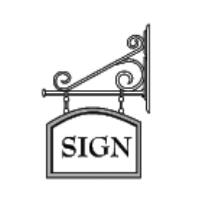
Figure 3-19. Projecting Sign
1. The maximum projection of a sign from a structure wall over a public right-of-way shall not exceed thirty-six inches over a sidewalk. Larger projections from the structure wall over private property may be approved by the review authority. Any projection over a public right-of-way shall require an encroachment permit.
2. The top of a projecting sign shall not exceed the lesser of fourteen feet, eave height, parapet height, or sill height of a second floor window. No portion of the sign shall project above the eave line of a sloped roof or the top of the parapet on a flat roof.
3. A projecting sign shall maintain a minimum clearance of eight feet from the bottom of the sign to the finished grade below.
4. Icon signs using shapes or symbols uniquely suited to the business, creative shapes, and three-dimensional signs are encouraged. See Figure 3-20.

Figure 3-20. Use of Icons/Symbols
5. Each sign shall be graphically designed for pedestrians, with a maximum area of nine square feet on each sign face, regardless of the length of the building frontage.
6. Sign supports shall be well-designed and compatible with the design of the sign.
G. Commercial Temporary Signs. The following temporary commercial signs are allowed within the CG, CD, CE, CI, and IG zoning districts subject to the applicable requirements:
1. Banners and Pennants. Temporary banners and pennants on private property shall comply with the following requirements:
a. The use of a banner or pennants may be allowed only for a licensed business for a total of thirty days each year. Each business is also allowed the one-time use of a banner for the first thirty days after the commencement of the business.
b. The application for a temporary sign permit for banners or pennants shall include the dates proposed by the applicant for scheduled banner use.
c. A bond shall be posted for a banner permit as required by the director. The bond may be called if the temporary banners are not removed within two days after the date when the permit required their removal.
d. Shall be located on the same property as the business being advertised.
2. Off-Site Signs. Because of the city’s compelling interest in ensuring traffic safety and the city’s interest in improving public convenience, off-site signs may be allowed on private property in compliance with the requirements of this subsection, with a sign permit.
a. Where Allowed. An off-site sign for commercial purposes may be approved within the CE, CG, CD, SPD, IG and CI zoning districts, only on sites where:
i. The review authority determines that a property owner has taken advantage of all permanent signs allowed by this chapter, and site visibility remains seriously impaired; and
ii. The structure which houses the business that is the subject of the sign message is on a parcel that is located more than one hundred fifty feet from a predominant public street frontage, the site is developed with all other signs allowed by this chapter, and the business entry and the other exterior signs allowed for the site by this chapter are not visible from the predominant public street. The “predominant public street” is the major vehicular route that provides access to the site and surrounding area; and
iii. Visibility of signage on the receiving parcel is not impaired, required landscape area is not removed or damaged, and off-site signage is integrated into the receiving parcel signage to every extent possible. For purposes of this section, “receiving parcel” means the parcel on which the off-site sign will be located.
b. Sign Standards. An approved off-site sign shall comply with all the following requirements and the sign standards for the applicable zoning district in Section 17.38.060, Zoning district sign standards:
i. Number, Size, and Height Limitations. Only one off-site freestanding sign shall be allowed. The sign shall not exceed an area of four square feet or a height of six feet.
ii. Design and Construction Standards. The appearance of the sign, including any graphics and/or text, shall reflect attractive, professional design, and the sign shall be durable and stable.
iii. Placement Requirements. The sign shall be placed only on private property, at the location specified by the sign permit.
H. Wall Signs. The following standards apply to wall signs (see Figure 3-21) in all zoning districts where allowed by Section 17.38.060 (Zoning district sign standards):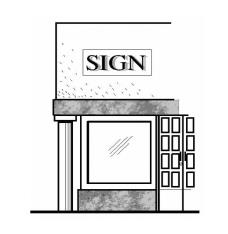
Figure 3-21. Wall Sign
1. Sign Location. A wall sign may be located on any primary or secondary structure frontage.
2. Maximum Sign Area. In addition to the limitations on sign area in Table 3-12, Section 17.38.060, the area of the largest wall sign shall not exceed seven percent of the area of the building facade on which the sign is mounted or painted, including the area of windows, doors, and recesses.
3. Projection from Wall Surface. A wall sign shall not project more than twelve inches from the surface to which it is attached.
I. Window Signs. The following standards apply to permanent window signs (see Figure 3-22) where allowed by Section 17.38.060 (Zoning district sign standards):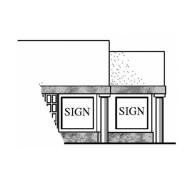
Figure 3-22. Window Sign
1. Sign Location. Window signs shall be allowed only on windows located on the ground level and second story of a structure frontage.
2. Maximum Sign Area. Permanent window signs shall not occupy more than twenty percent of the total window area.
3. Sign Materials. Window signs shall consist of individual letters, logos, or symbols applied to, stenciled on, or etched into the glass surface; however, neon signs with transparent backgrounds may be hung inside the window glass.
4. Temporary Window Signs. Temporary window signs are prohibited. (Ord. 885 § 2 Exh. A (part), 2019: Ord. 862 § 2 (part), 2016; Ord. 823 § 2(C) Exh. C (part), 2009; Ord. 766 § 2 Exh. A (part), 2004).
17.38.080 Nonconforming signs.
A nonconforming sign is any permanent or temporary sign that was legally established and maintained in compliance with the provisions of all applicable laws in effect at the time of original installation but that does not now comply with the provisions of this land use code.
A. General Requirements. A nonconforming sign shall not be:
1. Changed to another nonconforming sign;
2. Structurally altered to extend its useful life;
3. Enlarged;
4. Re-established after a business is discontinued for thirty days; or
5. Re-established after damage or destruction to fifty percent or more of the value of the sign, or its components, as determined by the building official.
B. Maintenance and Changes. Sign copy and face changes, nonstructural modifications, and nonstructural maintenance (e.g., painting, rust removal) are allowed without a sign permit up to a maximum of twenty-five percent of the existing total area of the sign. Face changes not including copy, and any nonstructural modifications exceeding twenty-five percent of the existing total area of the sign, and any structural changes shall comply with all applicable standards of this chapter. (Ord. 766 § 2 Exh. A (part), 2004).
17.38.090 Public nuisance, abatement, and violation.
A. Public Nuisance Declared by Director. Any sign erected or maintained contrary to the provisions of this chapter may be declared to be a public nuisance by the director and proceedings for its removal may take place in compliance with the municipal code.
B. Public Nuisance Declared by Council. The director may ask the council to declare a sign a public nuisance under the following conditions:
1. The sign is significantly damaged either in support structure or sign face, as determined by the building official;
2. The sign is illegible either through erosion, fading, or rusting of the sign face or through faulty or missing illumination; or
3. The sign is unsafe for pedestrians or vehicles.
C. Removal of Abandoned Sign. A sign shall be removed by the owner or lessee of the premises upon which the sign is located when the business that it advertises is no longer conducted on the premises. If the owner or lessee fails to remove the sign, the director shall give the owner thirty days’ written notice to remove it. Upon failure to comply with the notice, the director may have the sign removed at the owner’s expense.
D. Violations.
1. Any of the following is a violation of this chapter and subject to all penalties and procedures identified in Chapter 17.89 (Enforcement and Penalties) and the municipal code.
a. To create, erect, install, or maintain any sign in a way that is inconsistent with any plan or permit governing the sign or the parcel on which the sign is located;
b. To fail to remove any sign that is created, erected, installed, or maintained in violation of this chapter or for which the sign permit has lapsed.
2. Each sign created, erected, installed, or maintained in violation of this chapter shall be considered a separate violation when applying the penalty portions of Chapter 17.89 (Enforcement and Penalties) of this title.
3. Each day of a continued violation shall be considered a separate violation when applying the penalty portions of Chapter 17.89 (Enforcement and Penalties) of this title. (Ord. 766 § 2 Exh. A (part), 2004).
17.38.100 Appeal.
After denial of an application for a sign permit, the applicant may appeal that action in compliance with Chapter 17.84 (Appeals) of this title. The review authority shall act to grant or deny the appeal within sixty days of receipt of the request for review/appeal. (Ord. 766 § 2 Exh. A (part), 2004).
17.38.110 Judicial review.
Any permit issued or denied in compliance with this chapter shall be subject to expedited judicial review to the extent provided by the time limits identified in Code of Civil Procedure Section 1094.8 et seq. (Ord. 766 § 2 Exh. A (part), 2004).


